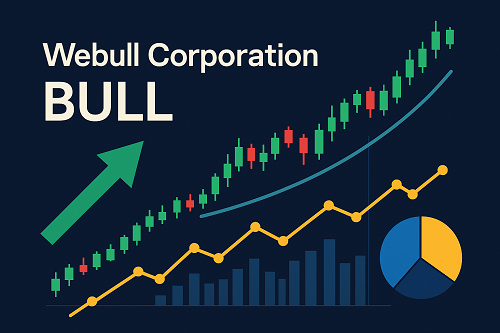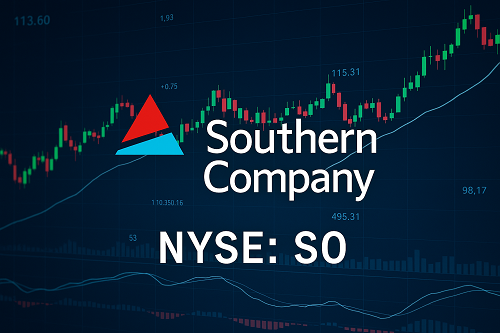Why BULL Matters
In the fast-evolving fintech landscape, Webull Corporation (ticker BULL) is a rising name. When considering investing in the Webull stock, it’s crucial to know it operates as an online trading platform that spans equities, options, crypto, and more, sitting at the crossroads of democratized finance and technological innovation.
Investors scrutinize BULL because it offers exposure to both trading / brokerage growth and crypto market cycles, making it a hybrid bet. This article dives far deeper than generic quotes — you’ll get institutional-level insight, scenario analysis, and actionable ideas.
Primary Keywords to Target:
- Webull stock BULL
- BULL stock analysis
- Webull Corporation outlook
- BULL share price forecast
- BULL valuation metrics
Company Overview: Webull Corporation
Webull Corporation is the financial services holding company behind the Webull trading platform.
Headquarters: St. Petersburg, Florida (U.S.)
Founded: 2016
CEO / Leadership: Anthony Denier (U.S. operations)
Business Lines:
- Commission-free stock and ETF trading
- Options trading
- Margin & derivatives
- Cryptocurrency trading (recently relaunched)
- International expansion, tokenization of assets, etc.
Webull’s ambition is to evolve from a pure retail brokerage into a full-stack fintech / trading ecosystem.
Business Model & Revenue Drivers
To assess BULL’s growth potential, we need to understand the levers of revenue and profit:
| Revenue Driver | Description | Growth Tailwinds |
|---|---|---|
| Trading Commissions & Fees | Though many trades are commission-free, Webull collects fees (e.g. clearing, margin interest, options premiums) | Greater trading volume, derivatives usage |
| Interest / Margin Income | Interest earned on margin loans or cash balances | Higher leverage adoption, rising interest rates |
| Payment for Order Flow (PFOF) | Payment from market makers to route retail order flow | More active retail traders, higher spreads |
| Crypto & Tokenization | Trading fees, spreads, swap income on crypto or tokenization of assets | Reintroduction of crypto, growth in digital asset adoption |
| Subscription / Premium Features | Advanced analytic tools, data subscriptions, API access | Upsell to active traders |
| International / Global Expansion | New markets, cross-border trading, localized services | Entry into APAC, EU markets |
Because Webull straddles both traditional securities and crypto, its revenue model is hybrid—and more exposed to market cycles.
Recent Financial Performance
Let’s dive into the latest metrics and trends to understand where BULL stands.
Revenue & Growth
- In Q2 2025, Webull reported ~46% year-over-year revenue growth fueled by increased trading activity.
- Customer assets under management soared ~64% year-over-year, hitting new highs.
These numbers show strong adoption momentum, especially in favorable markets.
Profitability
- The trailing twelve-month (TTM) net income is roughly USD 77.55 million as of latest reports.
- EPS (TTM) stands at ~0.36 USD.
- P/E ratio (trailing) ~ 37.6×.
While not yet in a dominant profitability position, BULL is showing signs of maturing.
Balance Sheet & Capital
- The company holds a reasonable capital structure with adequate liquidity. (Detailed balance sheet metrics are in Yahoo Finance Key Statistics)
- Outstanding shares and share count trends suggest manageable dilution.
Overall, Webull is scaling, but still in a growth-phase company profile—revenue growth is stronger than margin expansion.
Key Metrics & Valuation
Understanding valuation is critical. Below are cornerstone metrics and benchmark comparisons.
Market Metrics
- Current Share Price: ~USD 13.70 – 14.50 range (varying by source)
- Market Cap: ~USD 6.7–7.0 billion
- 52-Week Range: Roughly USD 9.54 to 79.56 (note wide breadth due to historic volatility)
- Beta (Volatility): Around –0.14 (indicating low correlation / idiosyncratic behavior)
Valuation Ratios
- Trailing P/E: ~37.6× (on TTM earnings)
- Forward P/E: ~101× (reflecting expectations or conservatism)
- EV / Revenue: (Requires enterprise value data)
- PEG Ratio: If growth continues, PEG could improve.
Compared to peers in fintech / trading, BULL is richly valued, but growth expectations may justify premium multiples if execution holds.
Competitive Advantages & Risks
Strengths & “Moats”
- Brand / Retail Trust & UX: Webull has strong brand equity among retail traders, with a smooth, user-centric interface.
- Hybrid Model (Equities + Crypto): Diversification reduces reliance on any single market.
- Scalable Infrastructure: Once the tech stack is built, incremental cost of adding volume is low.
- Network Effects: More users attract more liquidity, more trading, better spreads, and more features.
- Global Ambition: Expansion can unlock new markets.
Risks & Weaknesses
- Regulatory / Compliance Risk: Crypto and securities are heavily regulated; changes can hinder parts of the business.
- Market Volatility Dependence: In bull markets, trading activity surges; in bear markets, it can crash.
- Margin / Leverage Exposure: Risk of defaults or credit exposure in downturns.
- Competition Pressure: From Robinhood, Coinbase, Binance, traditional brokers moving into crypto.
- Profit Margins Under Pressure: As volume increases, so can costs (customer acquisition, compliance, server costs).
Technical Chart & Momentum Analysis
Though Webull is fundamentally driven, technicals offer supplementary input for timing.
- Support Levels: Near USD 12.50–13.00 based on recent price clusters.
- Resistance Levels: ~$15.50, $18.00 zones depending on momentum.
- Moving Averages: Watch interactions with 50-day and 200-day MAs for trend confirmation.
- Volume Trends: Volume upticks on up-days suggest accumulation; volume thinning on down-days is less concerning.
In periods of consolidation, the stock may trade sideways until a catalyst arrives.
Analyst Ratings & Price Targets
- Rosenblatt initiated coverage with a Buy rating and projected a target of USD 19.00+.
- Some analysts view BULL as “undervalued relative to growth potential” in recent commentary.
- Price consensus ranges vary; but many see mid-to-high teens as plausible zones.
As with any growth stock, expectations are high and disappointment could trigger downside.
Catalysts to Watch
Here are upcoming events and triggers that could move BULL significantly:
- Quarterly Earnings / Guidance: Exceeding guidance will reinforce growth narrative.
- Crypto Trading Activity: If crypto volume surges, incremental revenue will follow.
- Regulatory Developments: Favorable rules around tokenization or crypto could unlock upside.
- International Expansion Moves: Entry into major markets (e.g. EU, Asia) can re-rate the valuation.
- Partnerships / Acquisitions: Strategic deals in fintech or blockchain could accelerate growth.
A positive surprise in any of these could reset investor expectations upward.
Risks & Red Flags
Investors should proceed with caution. Some warning signs:
- Valuation vs Execution Gap: If growth slows, a P/E contraction could lead to sharp downside.
- Regulatory Crackdowns: Crypto rules or stricter brokerage oversight could cut margins.
- Liquidity Crises in Markets: In stress scenarios, trading often is the first to suffer.
- Overreliance on Retail Sentiment: Sudden sentiment shifts (e.g. sentiment to crypto) can reverse flows.
- Dilution Risk: Future capital raises or secondary offerings could erode earnings per share.
Mindful risk management and position sizing are crucial.
Strategy & Trade Ideas
Here are possible strategies for various risk profiles:
- Long-term core position: Allocate a modest percentage (1–5 %) in anticipation of fintech growth tailwinds.
- Swing trading / momentum plays: Use breakouts above key resistance (~USD 15–16) for shorter-term entries.
- Options strategies (for sophisticated traders):
- Bull call spreads (limited risk)
- Long calls ahead of earnings (volatility bet)
- Hedged exposure: Combine long BULL with a bearish hedge (e.g. short a correlated fintech index) to limit downside.
Always use stop-losses and do scenario-based sizing.
Frequently Asked Questions
Q1: Is BULL a good buy right now?
A: It depends on your risk tolerance. If you believe in fintech + crypto growth and can withstand volatility, BULL offers a growth lever. But it’s far from a safe “blue-chip” bet.
Q2: Does Webull pay dividends?
A: As of now, Webull Corporation has no dividend policy—it prioritizes reinvestment in growth.
Q3: How exposed is BULL to crypto market swings?
A: Quite a bit. As Webull integrates crypto trading, swings in crypto volume, regulation, or sentiment directly affect its revenue streams.
Q4: What is the upside / downside range?
A: Upside: potentially to USD 18–20+ if growth accelerates. Downside: could revisit USD 10–12 if growth disappoints or regulation tightens.
Conclusion & Investment Thesis
Webull Corporation (BULL) is a compelling, though volatile, play at the intersection of retail trading and crypto innovation. Its hybrid revenue model, strong growth momentum, and ambitious expansion plans make it attractive to growth-oriented investors.
But it carries real risks: valuation sensitivity, regulatory exposure, and reliance on continued market activity. To succeed with BULL, investors must:
- Keep close tabs on earnings and execution
- Use prudent position sizing
- Be ready to pivot if macro or regulatory winds shift
- f Webull can deliver on its vision, BULL has the potential to re-rate beyond current multiples. If not, it may revert sharply. This is a high-upside, high-risk fintech bet—appropriate for those who can stomach volatility and have conviction in digital finance trends.





 XAUT-USD
XAUT-USD  AMD
AMD  MARA
MARA  SHOP
SHOP  BULL
BULL  CL=F
CL=F